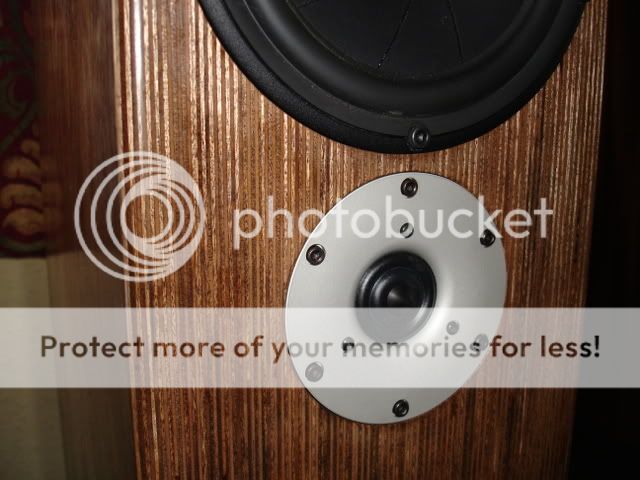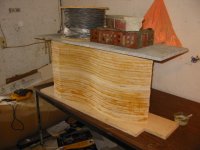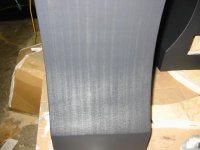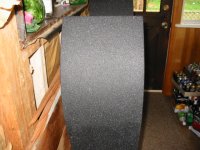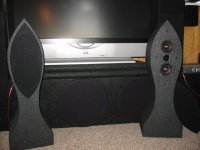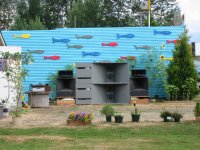Sorry about your hard work going a little south.I have had a few large projects were handed to me a few years ago to see if I could fix.
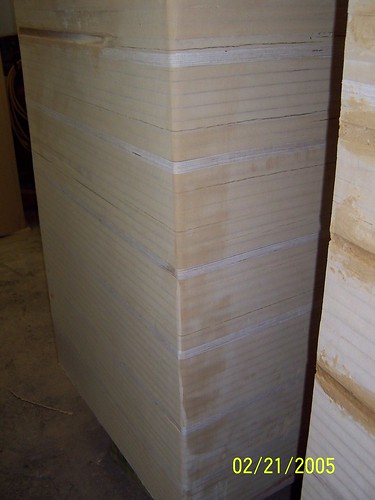

These were cracking so bad from moisture after coming to me it was unreal.Cracking got so bad I ened up using 2 gallons of Bondo scraping it on with a 2x4. Then reclanding them with 1/4" plywood on the exterior.
Here is a photo showing the top lag bolts around them.Then another 2 layers of Baltic Birch were placed on the top.
What I found was the torque from the bolts made it WORSE. Do not put compression on the wood.For long periods.It is different to clamping them to hold during glue drying.
In the end they worked out Great but with 3.5" thick they weighted over 280lbs and my customer got a moving company for the pick up and delivery to his place.Thankfully
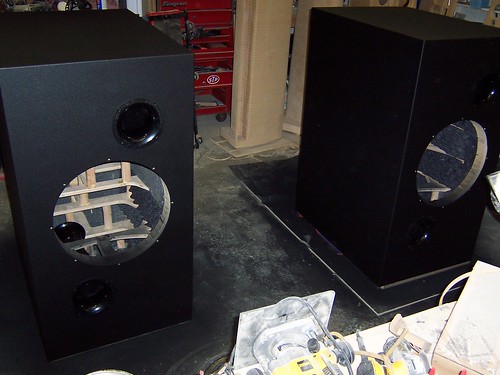
Now the large arrays I did for the same customer used the same method stacked and bolted MDF baltic layered.This array was for 12AC G1 ribbons with Accuton Mids Open baffled sitting onto of 4 TC 12" woofers then the large subs in the corners with 21" Aura's
Notice the curve that happened to the cabinet
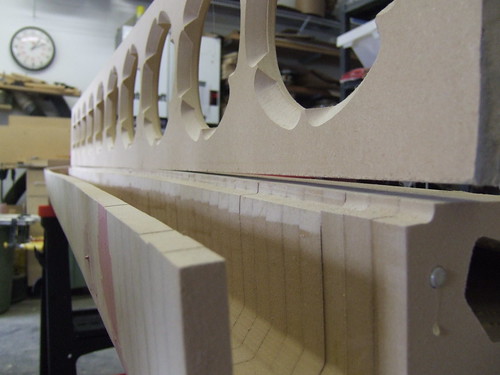
Here is them close to finished with a lot of cutting needed to get them to look like this.Book matched Paduke veneer.The outer stack was done for acoustic then the large panels the ribbons mounted to open back then the panel for the Accuton mids matching them together. This all sits on a W set of TC 12" subs OB.
In the end took my spare time over 3yrs to build as I did them

I hope you can make them work in the end but having the wood not sealed on both sides was the big thing I did in the end.
All the best
Did I read it right you recommend only coating one side? Either inside OR outside and not both?
Because I coated with 6 layers of Polyurethane on the outside and 2 layers on the inside. I figured the goal was to keep moisture from getting in. But I was aware it would "lock" the moisture in that was already there.
Can you remove the metal bolts? The only thing that expands and contracts like steel, is concrete.
Don't feel bad, I would have left the bolts in as well.
I recommend sanding back the broken edges, until there is enough room for a new layer of ply. I have done some translam projects. This should be possible.
If you leave the metal in, it will happen again.
Feel for you
Don't feel bad, I would have left the bolts in as well.
I recommend sanding back the broken edges, until there is enough room for a new layer of ply. I have done some translam projects. This should be possible.
If you leave the metal in, it will happen again.
Feel for you
Yes I did mean in and out but the big buttt. You have to watch the moisture to have the wood as dry as possible before sealing I side. Other than that yes you just seal in the moisture and it can take a very long time for it to slowly leatch out. I am out till later when I can give you more detail s. I know your pain like I said but on the largest scale you can think of.
Can you remove the metal bolts? The only thing that expands and contracts like steel, is concrete.
Don't feel bad, I would have left the bolts in as well.
I recommend sanding back the broken edges, until there is enough room for a new layer of ply. I have done some translam projects. This should be possible.
If you leave the metal in, it will happen again.
Feel for you
It will be very hard to remove the rods. Nearer to impossible I guess.
Also read OP's bit on 'glassing' them.....
If the same thing happens and there is a layer of glass involved, it will simply delaminate from the cabinet.
Are You prepared to itch for days?
This is a HUGE problem on wooden surfboards, unless the 'shape' is treated correctly for 'grain lift' before laminating, the cloth simply peals away.
Also the resin will heat the structure, it might split again.
Last balsa board I made took - from order to delivery 3 1/2 years, about 12months to find the balsa, 8 months to 'put together' and then about the same time for all the finishing, the rest of the time was spent waiting for the seasons / weather to be right to work.
I got the idea to laminate the structure from looking at boat building. It seems to be very common for plywood boats to be laminated with glass matt. I figured the stresses and abuse from temperature/moisture these boats see would be much greater than a pair of enclosures in a house.
I do hear you about raising the grain.
Yes I did mean in and out but the big buttt. You have to watch the moisture to have the wood as dry as possible before sealing I side. Other than that yes you just seal in the moisture and it can take a very long time for it to slowly leatch out. I am out till later when I can give you more detail s. I know your pain like I said but on the largest scale you can think of.
Hope to read more
Bamboo is great for stacking & layers
Hi guys,
Stable door, horse and bolted here, but for anyone else thinking about a multi layer build, if I was doing another multi layered construction ( top to bottom or front to back) I would use Bamboo plywood....
Either pure woven stranded or alternate layers of horizontal / vertical then stranded.
As a grass, not wood, bamboo has many sonic advantages, is incredibly strong, and is almost impervious to climatic variations, within reason.
It also looks stunning!
Down side is its 4 times the price of good Birch Ply and over 10 times the price of MDF....
If any one else is interested there are 3 other UK forum members interested in a group buy of a whole pallet, this makes it affordable in the UK.
Cheers
Derek.
Hi guys,
Stable door, horse and bolted here, but for anyone else thinking about a multi layer build, if I was doing another multi layered construction ( top to bottom or front to back) I would use Bamboo plywood....
Either pure woven stranded or alternate layers of horizontal / vertical then stranded.
As a grass, not wood, bamboo has many sonic advantages, is incredibly strong, and is almost impervious to climatic variations, within reason.
It also looks stunning!
Down side is its 4 times the price of good Birch Ply and over 10 times the price of MDF....
If any one else is interested there are 3 other UK forum members interested in a group buy of a whole pallet, this makes it affordable in the UK.
Cheers
Derek.
Wesayso,
With all due respect to OA...
Bamboo plywood wouldn't have changed anything. You already know the problem is the rods. I have used poplar plywood for this construction and had no problems whatsoever. A much smaller scale than yours, but the physics remains the same. I built a jig to surround my cabinets for alignment purposes and used weights in place of clamps. Next time around you can build a channel to hold the pieces aligned, lay them horizontal, using only glue and clamps, make up sections of a dozen or so pieces at a time and then glue the sections together.
It is so sad that hindsight is 20:20. I really hope you can do something with these. Like Al from RAW, and the others, we've seen how much has gone into them and really hope for the best.
With all due respect to OA...
Bamboo plywood wouldn't have changed anything. You already know the problem is the rods. I have used poplar plywood for this construction and had no problems whatsoever. A much smaller scale than yours, but the physics remains the same. I built a jig to surround my cabinets for alignment purposes and used weights in place of clamps. Next time around you can build a channel to hold the pieces aligned, lay them horizontal, using only glue and clamps, make up sections of a dozen or so pieces at a time and then glue the sections together.
It is so sad that hindsight is 20:20. I really hope you can do something with these. Like Al from RAW, and the others, we've seen how much has gone into them and really hope for the best.
If you look at Al's photos you can see a similar situation. The vertical braces are not going to compress as easily as the MDF will separate, and are essentially doing the same thing as the metal rods did in wesayso's box.
Don't worry Danny, just eliminate opposing forces.
Don't worry Danny, just eliminate opposing forces.
Weakest link in the chain...
Hi Cal,
Yes and no.... With all due respect ( you stealing my favourite line!)
Yes I agree, its the rods that caused the split as the expanding ply was not free to move & expand with the increase in moisture or shrink with the drying out, so the ply split as the weakest link.
Yes I agree that the rods were not needed ( as previously stated I didn't use them in the Encore build).
But....
I do disagree that bamboo would not help, I really think you are, well er a moderator (!) but you are wrong...Ok ban me now, you all hate me, its just a conspiracy...!!Lol and all that !
Seriously, bamboo is almost as resistant to atmospheric changes as alloy!
The problem would simply not have occurred with bamboo.
Its remarkable stuff.
Cheers
Derek.
Hi Cal,
Yes and no.... With all due respect ( you stealing my favourite line!)
Yes I agree, its the rods that caused the split as the expanding ply was not free to move & expand with the increase in moisture or shrink with the drying out, so the ply split as the weakest link.
Yes I agree that the rods were not needed ( as previously stated I didn't use them in the Encore build).
But....
I do disagree that bamboo would not help, I really think you are, well er a moderator (!) but you are wrong...Ok ban me now, you all hate me, its just a conspiracy...!!Lol and all that !
Seriously, bamboo is almost as resistant to atmospheric changes as alloy!
The problem would simply not have occurred with bamboo.
Its remarkable stuff.
Cheers
Derek.
Do you think you could manipulate the rods up/down enough to break the glue loose? If you can get the rods to move 'freely' the amount of the change in size or more, I suspect that you could stop this from being a reoccurring problem.
I'm thinking something like getting 2 half height nuts putting both of them on, then welding the top nut on and using a wrench (possibly ground skinny--I'd also use a box end) to hold the bottom nut as you turn the top nut to move the rod in/out.
I feel like the rods need to be there for situations where the ply is expanding to keep the finish from becoming a crackle finish, but they need to be free floating for cases of contraction. This IMO is 100% moisture related if you were going to have an issue with thermal expansion/contraction issues it would've happened the day you moved them from the garage to the house. (Assuming you keep a relatively stable temp in your house)
Also, have you measured the cabinet since it broke? I'm curious how much shrinkage would cause this.
I'm thinking something like getting 2 half height nuts putting both of them on, then welding the top nut on and using a wrench (possibly ground skinny--I'd also use a box end) to hold the bottom nut as you turn the top nut to move the rod in/out.
I feel like the rods need to be there for situations where the ply is expanding to keep the finish from becoming a crackle finish, but they need to be free floating for cases of contraction. This IMO is 100% moisture related if you were going to have an issue with thermal expansion/contraction issues it would've happened the day you moved them from the garage to the house. (Assuming you keep a relatively stable temp in your house)
Also, have you measured the cabinet since it broke? I'm curious how much shrinkage would cause this.
Derek, I have a secret to tell you.
When I am playing the role of Moderator, you will rarely see or hear me. When you see me posting, I am like any other member. If I was moderator all the time, what fun would that be?
I won't disagree the the bamboo is more stable but in this case it would simply translate to smaller separations. The number of laminates leads me to believe no ply would survive that. I think we are actually on the same page. The point of my post was to suggest the wood was not at fault, the execution was. I don't want Danny thinking that his Birch plywood was setting him up for failure.
I too like bamboo. So much so that I have rid my kitchen of all the hardwood cutting boards and now have all bamboo.
Cheers.
When I am playing the role of Moderator, you will rarely see or hear me. When you see me posting, I am like any other member. If I was moderator all the time, what fun would that be?
I won't disagree the the bamboo is more stable but in this case it would simply translate to smaller separations. The number of laminates leads me to believe no ply would survive that. I think we are actually on the same page. The point of my post was to suggest the wood was not at fault, the execution was. I don't want Danny thinking that his Birch plywood was setting him up for failure.
I too like bamboo. So much so that I have rid my kitchen of all the hardwood cutting boards and now have all bamboo.
Cheers.
Phew...I am safe!
Thanks Cal,
I was holding my breath there!
For sure the ply would not have split without the rods.
I did find my stack of ply ( approx. 38 layers of 25mm ) expanded and contracted enough to visibly ripple the Piano Black gloss and clear lacquer.
We ended up having to clad the stack in 6mm curved ply wood and then spray / lacquer on top of that.
Bamboo is the way to go for me from now on, the more I read the more I want it!
All the best
Derek.
PS That's some amazing PA gear you have, your driveway Rocks!!
Thanks Cal,
I was holding my breath there!
For sure the ply would not have split without the rods.
I did find my stack of ply ( approx. 38 layers of 25mm ) expanded and contracted enough to visibly ripple the Piano Black gloss and clear lacquer.
We ended up having to clad the stack in 6mm curved ply wood and then spray / lacquer on top of that.
Bamboo is the way to go for me from now on, the more I read the more I want it!
All the best
Derek.
PS That's some amazing PA gear you have, your driveway Rocks!!
Wesayso,
With all due respect to OA...
Bamboo plywood wouldn't have changed anything. You already know the problem is the rods. I have used poplar plywood for this construction and had no problems whatsoever. A much smaller scale than yours, but the physics remains the same. I built a jig to surround my cabinets for alignment purposes and used weights in place of clamps. Next time around you can build a channel to hold the pieces aligned, lay them horizontal, using only glue and clamps, make up sections of a dozen or so pieces at a time and then glue the sections together.
It is so sad that hindsight is 20:20. I really hope you can do something with these. Like Al from RAW, and the others, we've seen how much has gone into them and really hope for the best.
I think you are right here. It was one of the things that kept nagging at me, leaving in the steel rods. I literally observed these stacks every day while building them and storing them in the house. Observed many changes in dimension on the first I build, the second is the one that eventually cracked. But the biggest dimensional change I saw in that one is 2 mm length wise.
The other had moved at least 6 mm since I finished them. That's why I used rubber rings (more than one, about 6mm thickness at each side, top and bottom) to have the ability for the wood to move.
However, to avoid ringing from the studs I enclosed them every other layer in a rubbery glue. That was probably my biggest mistake.
I drive a Porsche 911, it has steel head studs and aluminum cylinders. That has been a mayor problem with these engines due to the differences in expansion. A lot of broken studs have occurred. They changed the 12 lower exhaust side studs to a material named dilavar. That material has about the same rate of expansion as aluminum. That knowledge should have saved me but I figured I could circumvent the issue by building in the movement with the rubber rings.
For now, I think I'll leave my towers the way they are. Both are in one piece after the rescue of the broken one. However that was done by torqueing down the nuts, no telling what that will do in the long run. I'll continue to finish this built as is. Observing what the enclosures will do as they are now and in the spring I'll make up my mind what to do next. That could mean I'll have cracked enclosures in a few weeks time but maybe I'll be in luck.
I will make sure not to glue anything permanent to the enclosure to have something to work with if necessary.
One thing I did notice as a general opinion on woodworker sites: You'll never stop the wood from moving (no surprise there), but you can slow it down to a degree. The most successful coat to do that seems to be epoxy. Now I only need to figure out if using matt in the epoxy as a laminate is a big NO as stated earlier in this thread.
It seems to work for the boat building guys... they often use the thinner matt from glass fiber, not the much stiffer carbon or aramid.
Last edited:
In my experience with boats, the mat over ply delaminates with time. The type of mat doesn't seem to matter. Speaker are a different story so you might be ok, but that's gonna be one heck of a lot of work to get a decent finish out of it. If it were me, I would go the thin ply route then do your finish over that, what ever you choose. As far as sealing, I used many coats of paint to seal and to get rid of the laminate lines, lots of sanding, then a texture coat to finish. 7 or 8 years later, no problems.
Just for fun, I used the cut-out centres to cover a industrial wall at my friend's place. The Fish Wall.
Cheers.
Just for fun, I used the cut-out centres to cover a industrial wall at my friend's place. The Fish Wall.
Cheers.
Attachments
- Home
- Loudspeakers
- Full Range
- The making of: The Two Towers (a 25 driver Full Range line array)
